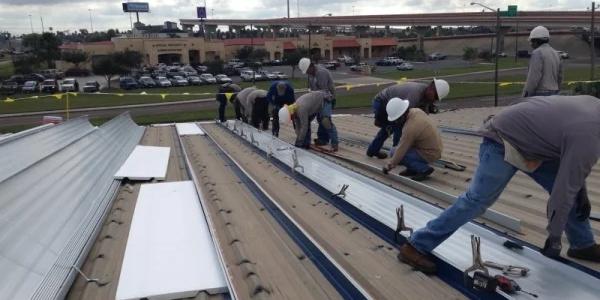UP TO THE MINUTE
Comparing Roof Materials and How to Determine Which Type is Right for Your Home

By Anna Lockhart.
Roofs can come in all shapes and sizes, and when it comes to determining which type of roofing material is right for your home, it can be a lot to take in. Check out this guide to find out the pros, cons and outstanding factors about each roofing material!
Editor’s note: The Metal Roofing Alliance (MRA) has organized the Residential Metal Roofing Buyer’s Guide to help homeowners learn about the basics of roofing. This article discusses the different kinds of roofing materials using a passage from the guide.
For the average home or building owner, deciding on roofing material can be difficult without adequate information. Installing a roof is a large investment, and buyers should know exactly what kind of investment they are in for depending on the material they choose. The Metal Roofing Alliance (MRA) is dedicated to educating home and building owners on the basics of roofing and how to determine what materials to choose based on their needs and budget. This article, based on the informative Residential Metal Roofing Buyer’s Guide, will walk you through the basics of common roofing material types so that you can make an informed decision on what to put on your roof.
Metal vertical seam
For home and business owners looking for roofing material that has a long lifespan, high durability and is environmentally friendly, a metal roof might be the best option. Metal vertical seam roofs offer a look that is unique compared to the traditional look of shingles, giving a modern and even colorful appearance. Buyers can choose from a variety of styles and colors, getting a stylish roof while also cutting back on energy use and waste, as metal roof panels are often made of recycled materials and are energy efficient.
A metal vertical seam roof can cost anywhere from $500-$2,500 per square depending on the brand and style, which might be a high upfront cost compared to traditional materials, but the metal panels make up for it in the up to 30% in energy savings it brings to owners and the over 50-year typical lifespan. Buyers can expect to get a 30–40-year warranty on this style of roof as well as a typical workmanship warranty from the installer.
Metal stamped panel
Similar to the metal vertical seam, the metal stamped panel offers owners many benefits when it comes to energy savings, long lifespan and sustainability. This metal panel type is made to mimic the look of traditional asphalt shingles and come in a wide range of colors and textures.
Metal stamped panels can cost $900-$2,500 per square. Like the vertical seam panels, they are also fade and chalk resistant with both PVDF or SMP paint systems or stone coated steel modular systems.
Asphalt
For those looking for a traditional style and look, the asphalt shingle might be a contender. While the upfront cost of asphalt shingles are cheaper than that of metal, ranging from $350-$900 per square, these shingles require replacing every 10-20 years and require a great deal of upkeep and inspections.
Available in a variation of shades, the asphalt shingle is the traditional way to go for those insistent on a classic look and method. Though considered classic, this material is prone to fast aging and fading as well as re-caulking and sealing as it ages. With a lifespan of only 15-20 years and often limited warranties, this material option comes with a lot of upkeep needs.
Clay and concrete tile
For those looking for a material with a long life but aren’t necessarily sold on metal materials, clay and concrete tiles are made to last upwards of fifty years and carry 30–50-year warranties. In addition to its long lifespan, fans of this material also enjoy a wide range of styles, though in limited color schemes, and a slight energy efficiency.
In choosing this material owners will need to inspect the roof often in case of cracks or sliding, as they are prone to wind damage and will need the occasional repair to damaged or displaced tiles. This option costs, on average, $700-$2,000 per square.
Shake
For the home or building owner with a taste for rustic and natural designs, the shake roof shingle might be an option to consider. Made from sustainable materials if purchased from certain eco-friendly sources, this material is an option for those with environmental concerns in mind.
With a cost of $800-$1,500 per square, it is also important to keep in mind that shake requires frequent repairs and upkeep as it is susceptible to mold and rot, and it has a short warranty period of 5 years on average. This roofing option has an expected lifespan of 10-12 years.
Slate
Slate roofing is a considerable option for those looking for the roofing material with the maximum lifespan possible. Slate has an average lifespan of 75+ years and an average 50+ year warranty to match. Another reason this material is popular with some building and homeowners is because of its natural source and look. While these are phenomenal features in their own way, there are other factors to consider first before choosing this option.
Slate is a very heavy material, so the structure it is being put on must have a sturdy foundation and build. The material’s weight will also mean that there will need to be yearly inspections, occasional crack repair and an increased shipping expense. Slate will run buyers an average of $1,200-$3,000 per square, a hefty price to pay for an equally heavy material!
Learn more about Metal Roofing Alliance (MRA) in their Coffee Shop Directory or visit www.metalroofing.com.



















Comments
Leave a Reply
Have an account? Login to leave a comment!
Sign In